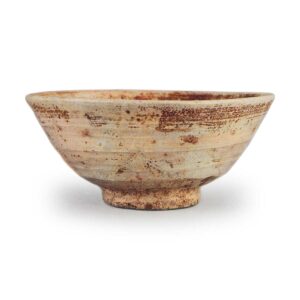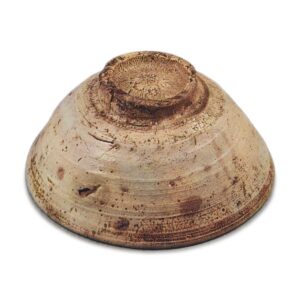

Height: 6.0-6.5cm
Diameter: 14.2cm
Outside diameter of foot ring: 5.5cm
Height of foot ring: 1.0cm
There are a relatively large number of hard-handled tea bowls, but there are very few that are worth looking at. Most of them are of the hachi-te, sun-kate or okura-kate type, and all of these are thick and heavy to the touch. The glaze is thin and there is little variation, so many of them are monotonous. The former is a kind of Kinka-kente with a powdery white color and often has red specks, like the red specks on the surface of a book. The name “Okura-kente” comes from the fact that it was produced in large quantities and stored in a warehouse, and the unglazed body is grayish and the glaze is a pale blue-gray color, making it a tasteless, low-quality product. In contrast, the tea bowls we see here, such as the Katate tea bowl, are full of highlights, from the way they are made to the glaze, and it would not be strange to find them in the hands of a tea master. There are very few tea bowls that show the elegant purple spots that are unique to Kinkai, and the red and blue fire change is particularly magnificent. As a rare masterpiece among similar bowls, it is most fitting that Tanimatsuya Toda Yashichi (Rogen) praised it in his “Gogaku-shu” (Collected Works of Later Students). This is probably an old work of Kinkai Kente. The fine lines of the outer surface are crisp and vivid, and the wheel marks are rough and well-defined. The scraping on the side of the foot ring is also well-defined. The fine texture of the clay, especially around the base and up to the foot ring, has produced a beautiful crepe texture, and it is hard to find another piece of pottery with such a fine crepe texture. The foot is made of bamboo joints, and the center bulges out in a gentle, rounded shape. The style is the same as that of old Katsutei ware, with a rough, unglazed earthenware look, but the overall impression is light and airy, and it is slightly smaller and shallower than other famous Katsutei ware bowls. The glaze is soft and both inside and out it has a light reddish hue, but the light yellow color that appears in the glaze is reminiscent of the fire-changing technique used in Toto-ya ware. The purple-tinged rain leakage and the stone-like texture in one place add to the overall charm of the piece.
The most notable feature of this teacup is the strong turning at the foot of the rim, and the beautiful creased foot reminiscent of the shiitake foot of a Hontou Toto-ya teacup.
The fact that it is small but has a deep interior is also impressive, and there are a few fine cracks in the center of the tea pool that appeared during firing. There is no eye on the inside or outside. The tea stains on the rim also add a certain charm.
From a practical point of view, it has the characteristic of becoming noticeably moist on the glaze surface when exposed to moisture, so it is good to use during the rainy season in Japan, and it also shows a change in flavor when used during the time of the light rain. In that respect, it is a more attractive teacup than those that are only used during a limited time of the year.
This was formerly owned by Matazaemon Shibakawa of Osaka.



